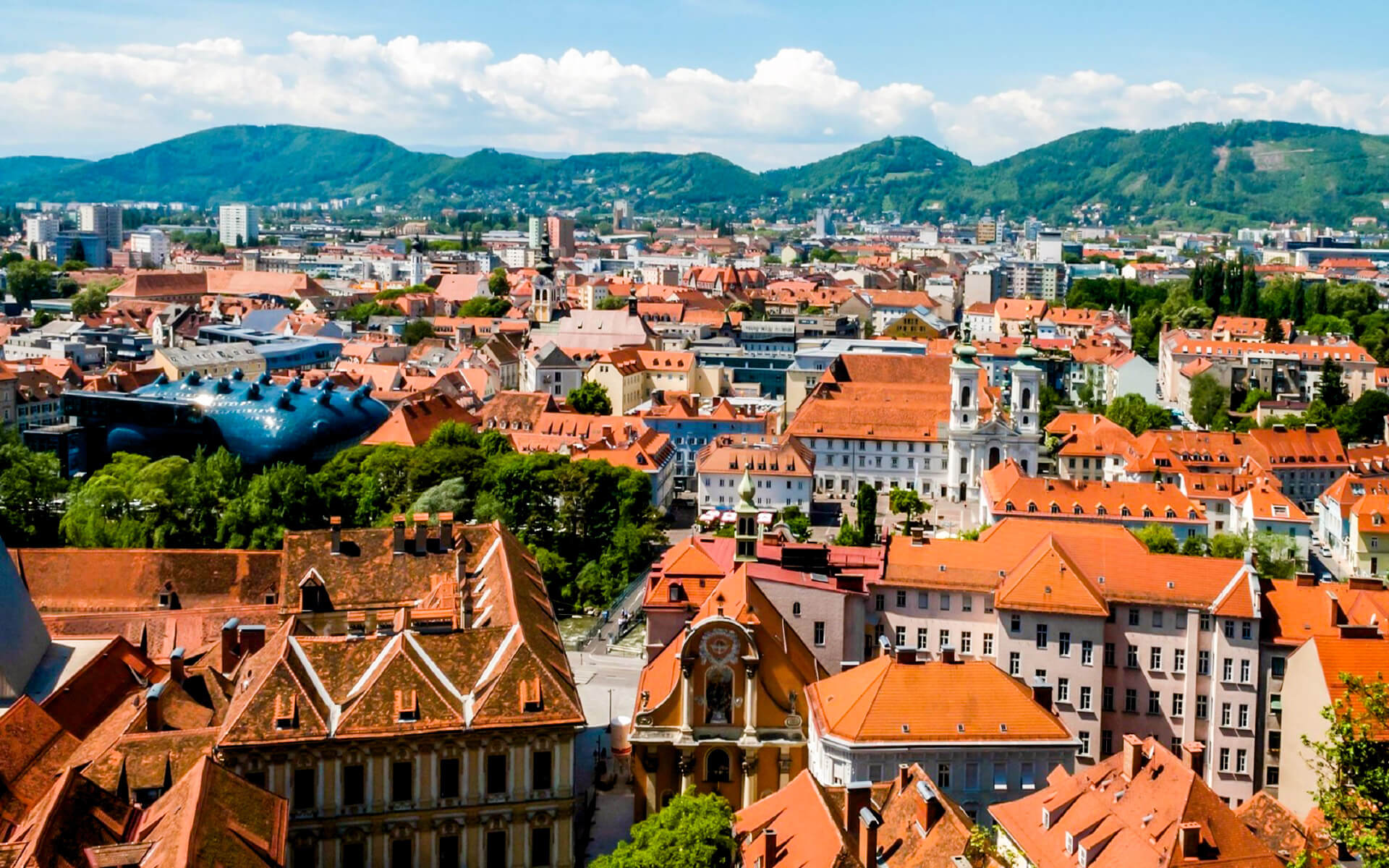Graz’s term as Cultural Capital of Europe resulted in the construction of numerous startlingly contemporary new public buildings. The most well-known is the Kunsthaus (house of contemporary art) created by Peter Cook and Colin Fournier, a museum built exactly next to the Mur River, and the “Murinsel” (island in the Mur), a steel island located in the river. Vito Acconci, an American architect, created it, and it has a café, an open-air theater, and a playground.
OLD TOWN
The old town was included on the UNESCO World Heritage List in 1999 owing to the peaceful coexistence of distinctive structures from several epochs and architectural styles. Graz, located on a cultural crossroads between Central Europe, Italy, and the Balkan states, absorbed numerous influences from the neighboring areas, giving rise to its distinctive townscape. The old town now has around 1000 structures ranging in date from Gothic to contemporary.
- Rathaus (Town Hall).
- Schloßberg, a hill overlooking the old town (475 m (1,558.40 ft) high), location of a ruined stronghold offering views of Graz.
- Uhrturm clocktower, an icon of Graz, stands atop Schloßberg.
- Neue Galerie. Art gallery.
- Schloßbergbahn, a funicular railway up the Schloßberg.
- The Landhaus, is a Lombardic-style mansion that houses the federal state parliament of Styria. It is one of the most prominent examples of Renaissance architecture in Austria, and it was erected between 1557 and 1565 by the Italian architect Domenico dell’Allio.
- The Landeszeughaus, armoury, the largest of its kind in the world.
- The Opernhaus – The main venue for opera, ballet, and operetta performances is the Opernhaus. It is Austria’s second biggest opera house.
- The Schauspielhaus, the principal theatre for productions of plays.
- Dom (cathedral), a remarkable Gothic architectural relic. There were formerly numerous frescos on the outside walls; now, only a few survive, such as the Landplagenbild (“image of plagues”), which was apparently painted in 1485 by Thomas von Villach. The three plagues shown are locusts, disease, and a Turkish invasion, all of which struck the town in 1480. It houses Graz’s oldest painted vista.
- Mausoleum – The Emperor Ferdinand II Mausoleum, located near to the cathedral, is Graz’s most prominent Mannerism edifice. It contains both Ferdinand II’s and his wife’s graves, as well as a cathedral dedicated to St Catherine of Alexandria.
- Burg (castle complex) – Emperor Frederick III erected the Burg (castle complex) with Gothic double staircase between 1438 and 1453 because the former castle atop the Schloßberg was too tiny and inconvenient. The Burg served as the Inner Austrian Court’s home until 1619. It now serves as the Styrian government’s official house.
- Gemaltes Haus (“painted house”), in Herrengasse 3. It is entirely decorated with frescoes (painted in 1742 by Johann Mayer).
- Kunsthaus (museum of modern art).
- Murinsel, an artificial island in the Mur.
- Buildings, courtyards (e. g. Early Renaissance courtyard of the Former House of Teutonic Knights in Sporgasse 22) and roofscape of the old town.
OUTSIDE THE OLD TOWN
- Schloss Eggenberg is a Baroque castle in Graz’s western outskirts with state chambers and a museum. It was added to the existing World Heritage site of Graz’s historic center in 2010.
- Basilika Mariatrost a late Baroque church in Graz’s eastern outskirts.
- The Herz Jesu Kirche is Graz’s biggest church, with the third tallest spire in Austria, and was erected in the Gothic Revival style.
- Calvary Hill in Graz’s Gösting district, including a 17th-century calvary and church.
- The LKH-Universitätsklinikum, is Graz’s largest hospital and one of the largest in Austria. It is Austria’s greatest Jugendstil building complex, constructed between 1904 and 1912. It is a state-run hospital and one of the most prestigious in Austria and Central Europe.
- The best sites for city views are Ruine Gösting, a hilltop castle ruins on the city’s northern outskirts, and Plabutsch/Fürstenstand, a hilltop restaurant and observation tower behind Schloss Eggenberg.
GREATER GRAZ AREA
- Österreichisches Freilichtmuseum Stübing, an open-air museum with rebuilt antique farmhouses/farm buildings from all around Austria in a historic setting.
- Lurgrotte, The largest extensive cave system in Austria.
- Lipizzanergestüt Piber, a Lipizzaner stud in Piber that breeds the famed horses.
- The Steirische Weinstraße popularly called as “Styrian Tuscany,” is a wine-growing area south of Graz.
- Thermenregion, is a spa region located east of Graz.
- Riegersburg, a formidable fortification that was never conquered. It served as a fortress against Turkish incursions.
Graz is protected from the predominant westerly winds that bring weather fronts in from the North Atlantic to northwestern and central Europe due to its location southeast of the Alps. Graz’s weather is consequently affected by the Mediterranean, and it enjoys more sunny hours per year than Vienna or Salzburg, as well as less wind and rain. Graz is located in a basin that is solely accessible to the south, resulting in a milder temperature than would be anticipated at that latitude. Plants that grow far further south may be found in Graz. However, the city’s air quality suffers as a result of the warmer, less windy environment, which renders it prone to smog in winter. The exhaust fumes from the approximately 120,000 automobiles driven into Graz every workday by persons living in the surrounding districts, together with car travels made by Graz residents, constitute the most major cause of air pollution.
Graz is located in southeast Austria on the Mur River. It is located roughly 200 kilometers (120 miles) southwest of Vienna. Maribor, Slovenia’s largest city, is roughly 50 kilometers (31 miles) away. Graz is the capital and biggest city of Styria, a lush and wooded region.


